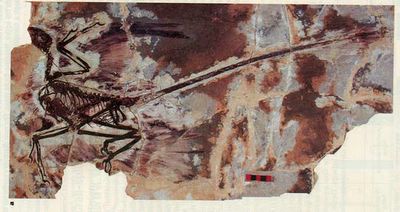The evolution of airplanes from the Wright Brothers’ first biplanes to monoplanes was an inadvertent replay of the much earlier evolution of dinosaur flight, say two dino flight experts.

Figure 1. A biplane glider Microraptor gui from China compared with the Wright 1903 Flyer. Microraptor invented the biplane 125 million years ago (courtesy: Jeff Martz).The Feathered Dinosaur Microraptor: Its Biplane Wing Planform and Flight Performance. Sunday, 16 October, 4:00 p.m. MDT, Salt Palace Convention Center 151 ABC.
According to paleontologist Sankar Chatterjee and retired aeronautical engineer R.J. Templin, a small early Chinese dinosaur called Microraptor gui used a two-level, biplane wing configuration to fly from tree to tree in the early Cretaceous. Among the evidence for the early biplane is that Microraptor had unmistakable flight feathers on its hind limbs as well as on its wings, says Chatterjee, a distinguished professor at Texas Tech University in Lubbock. The Chinese paleontologists who first reconstructed Microraptor had guessed that its four wings were used in tandem, similar to those of dragonfly.
“The most unusual thing is that they have flight feathers not only on the hand section, but also on foot,” said Chatterjee. Flight feathers differ noticeably from other feathers in that they are asymmetrical with interlocking barbules to keep their shape. The leading edge of each long feather was narrower than the trailing edge, which helped streamline the body in flight. The hooked, interlocking barbs gave strength and flexibility to the feather and prevented air from passing through it in flight.
Another key element to discovering Microraptor’s flight secrets was setting some realistic limitations on how the dinosaur could move its hindlimbs – something that was initially overlooked by Chinese researchers who found the fossil. Chatterjee and Templin studied its anatomy and found that like any dinosaur, Microraptor held their hindlimbs in erect, vertical plane, permitting forward and backward motion.

Figure 2. Skeleton of Microraptor gui, a feathered dinosaur from the early Cretaceous (about 125 million years old) of China has preserved traces of feathers in the wings and legs, suggesting a biplane configuration. The animal was about 30 inches long with a bony tail and weighed about 2 pounds (courtesy: Dr. Xing Xu)“The problem we faced is that the legs of Microraptor, like on any dinosaur, could not be splayed sideways,” as the Chinese paleontologists assumed. That means Microraptor could not have extended its rear limbs to form a wing directly behind the front wing. More likely, and more aerodynamically stable, would have been a rear wing that was held lower than the front wing – what from the side would look like a staggered biplane configuration, Chatterjee explains.
Chatterjee and Templin fed Microraptor’s flight data into a computer simulation that they have previously used to successfully analyze the flying abilities of pterosaurs and Archaeopteryx. Based on the aeronautical analysis, it appears that Microraptor flights looked rather like those seen today among some “monoplane” forest birds -- something called undulating phugoid gliding, Chatterjee said. In other words, Microraptor launched from a high branch and dove off, falling head-first until it reached a speed that created lift on its wings. With that lift the feathered dino then swooped upwards and landed in the branches of another tree without having to flap its wings and expend muscular energy.
“The biplane wing configuration was probably a very first experiment in nature,” says Chatterjee of the early flying technique, which was also used by another feathered dinosaur from China, Pedopenna, he said. Archaeopteryx achieved fully powered flight with monoplane configuration, as its wing became even larger than those of Microraptor, but foot feathers
were lost.
Read the full press release HERE.